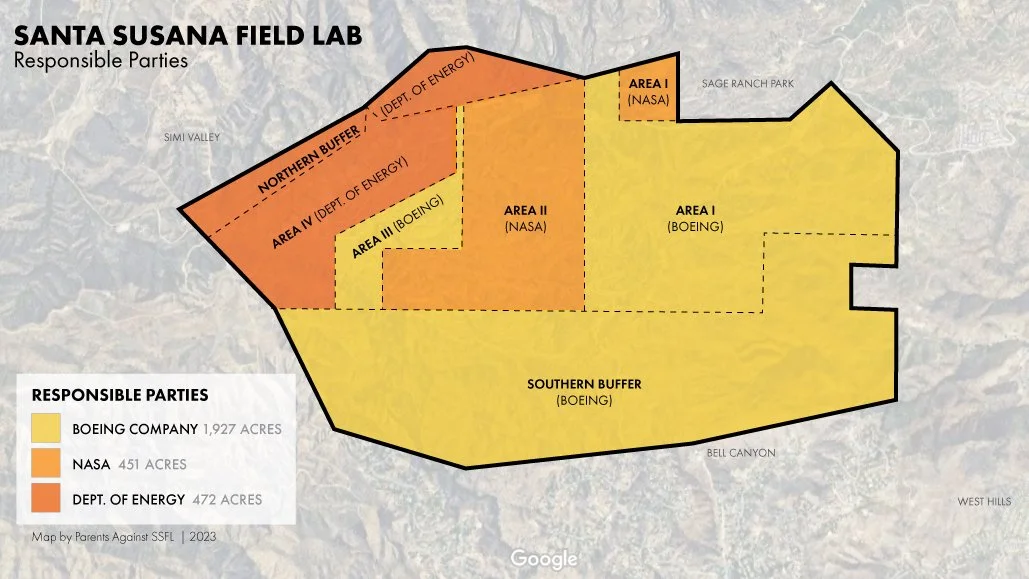
Cleanup SCENARIOS
SSFL > CLEANUP > CLEANUP SCENARIOS
The Santa Susana Field Lab (SSFL) is one of the most contaminated sites in California. Decades of nuclear energy experiments and rocket engine testing resulted in extensive pollution of the site’s soil and groundwater. After learning that children were getting cancer from the site, former CalEPA Secretary Linda Adams began negotiating cleanup agreements with the site’s three Responsible Parties: the Boeing Company, NASA, and the US Department of Energy.
The cleanup agreements were intended to make the site as safe as possible for the 700,000 people who lived nearby. Former Republican Governor Arnold Schwarzenegger and former Democratic Senator Barbara Boxer championed the original SSFL cleanup agreement in 2007. Congresswoman Julia Brownley and former State Senator Sheila Kuehl were instrumental in passing the 2010 cleanup agreement that created the unprecedented cleanup to “Background,” that is, to remove all man-made contamination in order to return the site to it’s natural condition.
It was assumed that the cleanup was won and the site would be completely cleaned up by 2017, as agreed to. By 2015 it became clear that the Responsible Parties, led by Boeing, continued to fight against a full cleanup. They employed all manner of deceit, including lawsuits, greenwashing tactics, hiring lobbyists from CalEPA and DTSC, introducing weakened cleanup scenarios into their proposals, and watered-down calculations that would allow more contamination to remain onsite.
In the last few years, the three Responsible Parties have been successful in weakening their cleanup obligations under the authority and approval of CalEPA and the Department of Toxic Substances Control (DTSC).
PASSFL is leading the charge, along with residents and environmental NGOs, to fight back against the powerful responsible parties and return to an agreement that would completely clean up the site to “background.”
It’s logical to assume that toxic site cleanups remove all contaminated material, but that’s rarely the case.
In California and across the U.S., cleanup agreements heavily favor Responsible Parties (RPs)—such as Boeing, NASA, and the Department of Energy at SSFL—because these parties are often contracted to write the agreements. This allows them to cut corners, save money, and protect their reputation. Regulatory Agencies like CalEPA and the Department of Toxic Substances Control (DTSC) approve these agreements with little resistance due to pressure from politically and financially powerful RPs. Risk-based cleanups are cheaper and faster, making them the preferred choice of RPs, even though they leave lasting harm.
RPs frequently rely on Risk-Based Scenarios to shape cleanup agreements, using EPA models to estimate exposure risks. The standard target is to ensure no more than 1 in 1,000,000 (1 × 10⁻⁶) people develop cancer due to remaining contamination. However, these calculations depend on assumptions about human activity.
For instance, a Residential with Garden scenario requires a more thorough cleanup since it assumes people live on-site and eat food from a backyard garden. In contrast, a Recreational scenario assumes visitors spend only a few hours per year on-site, with little exposure to the site’s contamination. The Recreational scenario allows RPs to leave almost all contamination onsite with a smaller risk to the occasional visitor but not the families living next to SSFL, where pollutants migrate into their homes and environment.
Pros of Risk-Based Scenarios
Inexpensive to Responsible Parties.
Quicker to implement.
Ignores past harm and current liabilities to residents.
Cons of Risk-Based Scenarios
Calculations are often based on the metabolism and lifestyle of a white adult male, ignoring more vulnerable populations.
Doesn’t account for contamination spreading to surrounding communities, water, or wildlife.
Fails to consider long-term consequences. In 200 years, residents may rely on local groundwater, but a recreational cleanup wouldn't ensure its safety.
After a cleanup is “completed” to any level, RPs will almost never return to do a better cleanup later, even if dangerous contamination is discovered to remain onsite.
A Background Scenario cleanup was designed to counteract the unfair influence of RPs in cleanup agreements. Unlike Risk-Based Scenarios, which rely on modeling and calculations, a Background Cleanup uses real sampling data. It assumes that if a contaminant on-site is man-made, it should be removed, restoring the land to its natural state before it was polluted.
To determine the site's natural condition, scientists collect data from nearby unpolluted areas. Any detected chemicals or radioactive materials naturally found in the environment, like radon or uranium, were considered "background" levels.
While a Background Cleanup scenario doesn’t require RPs to clean beyond natural background levels, it often results in a more thorough cleanup than most Risk-Based Scenarios.
Pros of Background Cleanup Scenario
Returns the toxic site to its natural condition.
Protects residents, water, and wildlife near the site and at the site.
Assumes man-made contamination has the potential to cause harm, even if the full extent of the harm isn’t currently known.
Cons of Background-Based Scenarios
Expensive to the Responsible Parties.
Take more time to implement.


